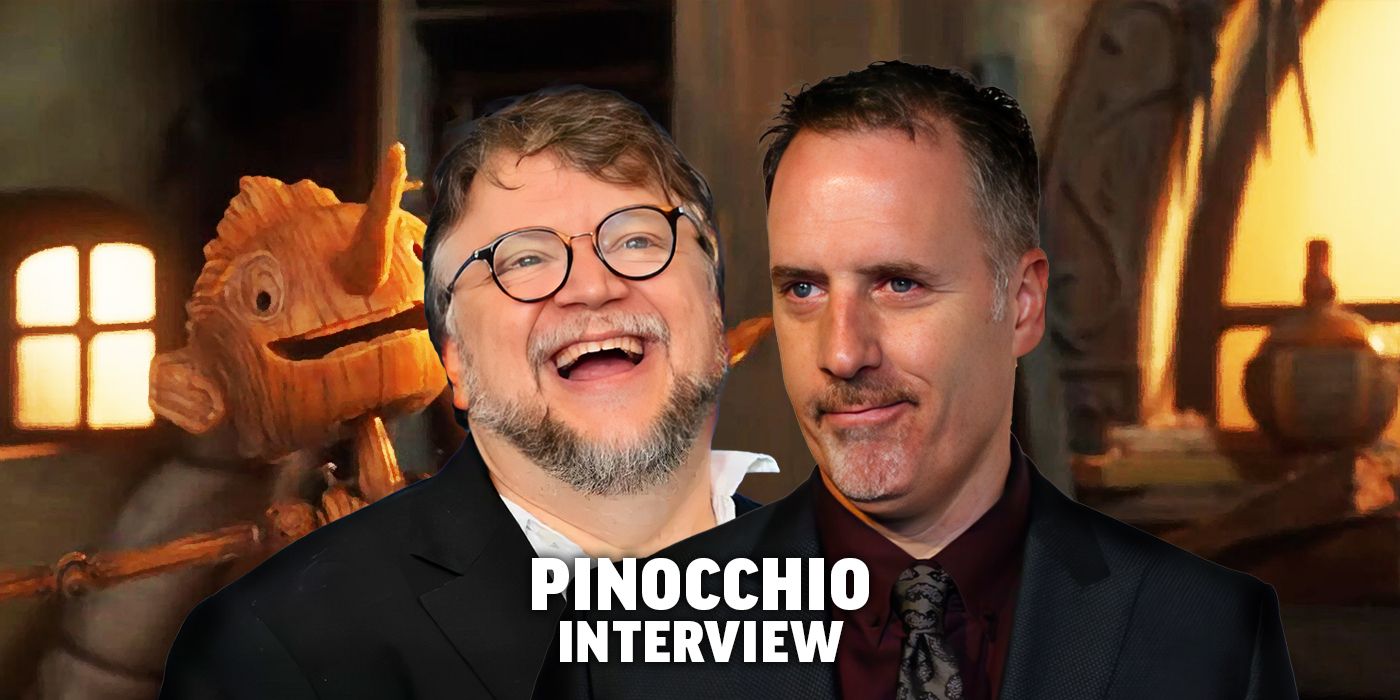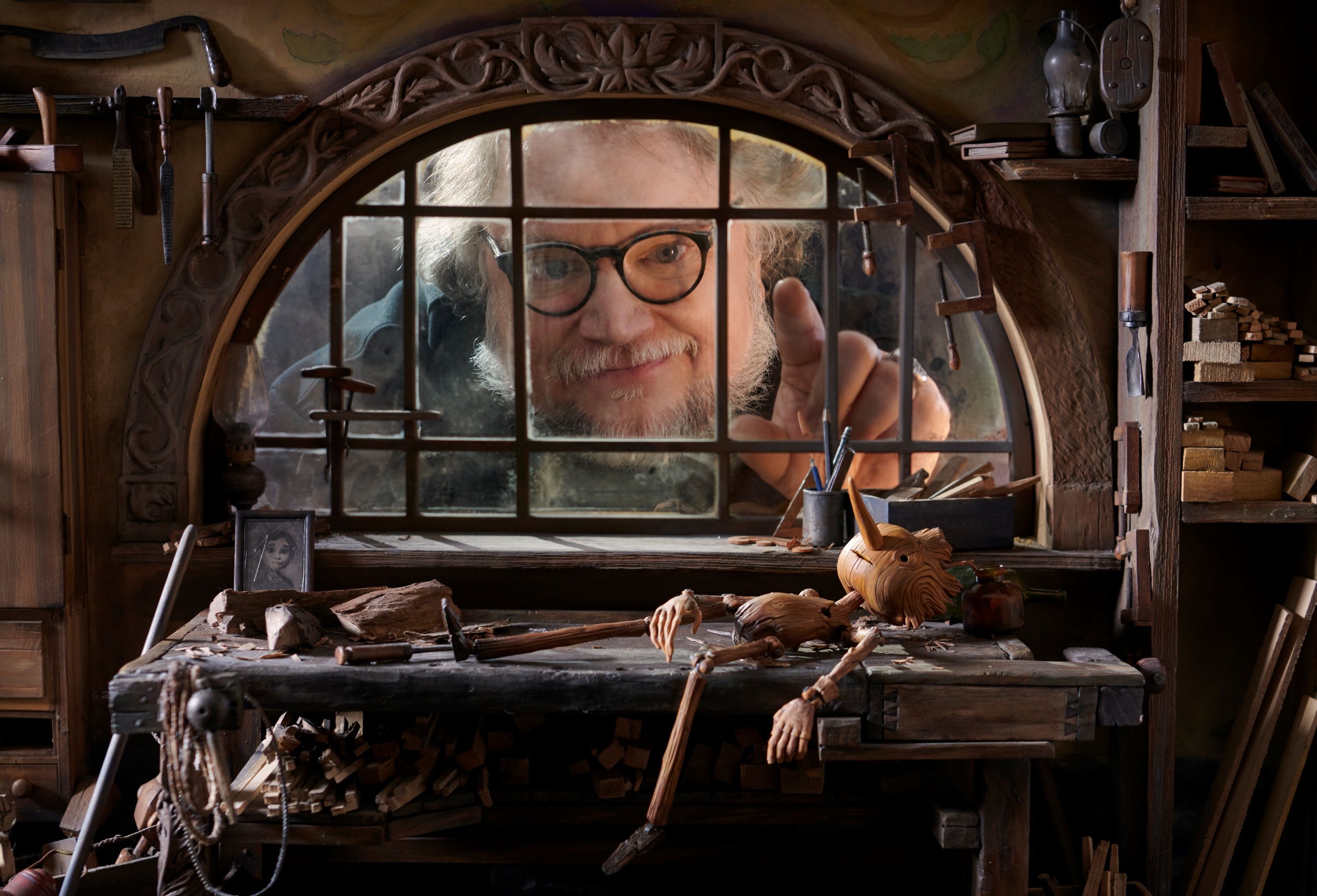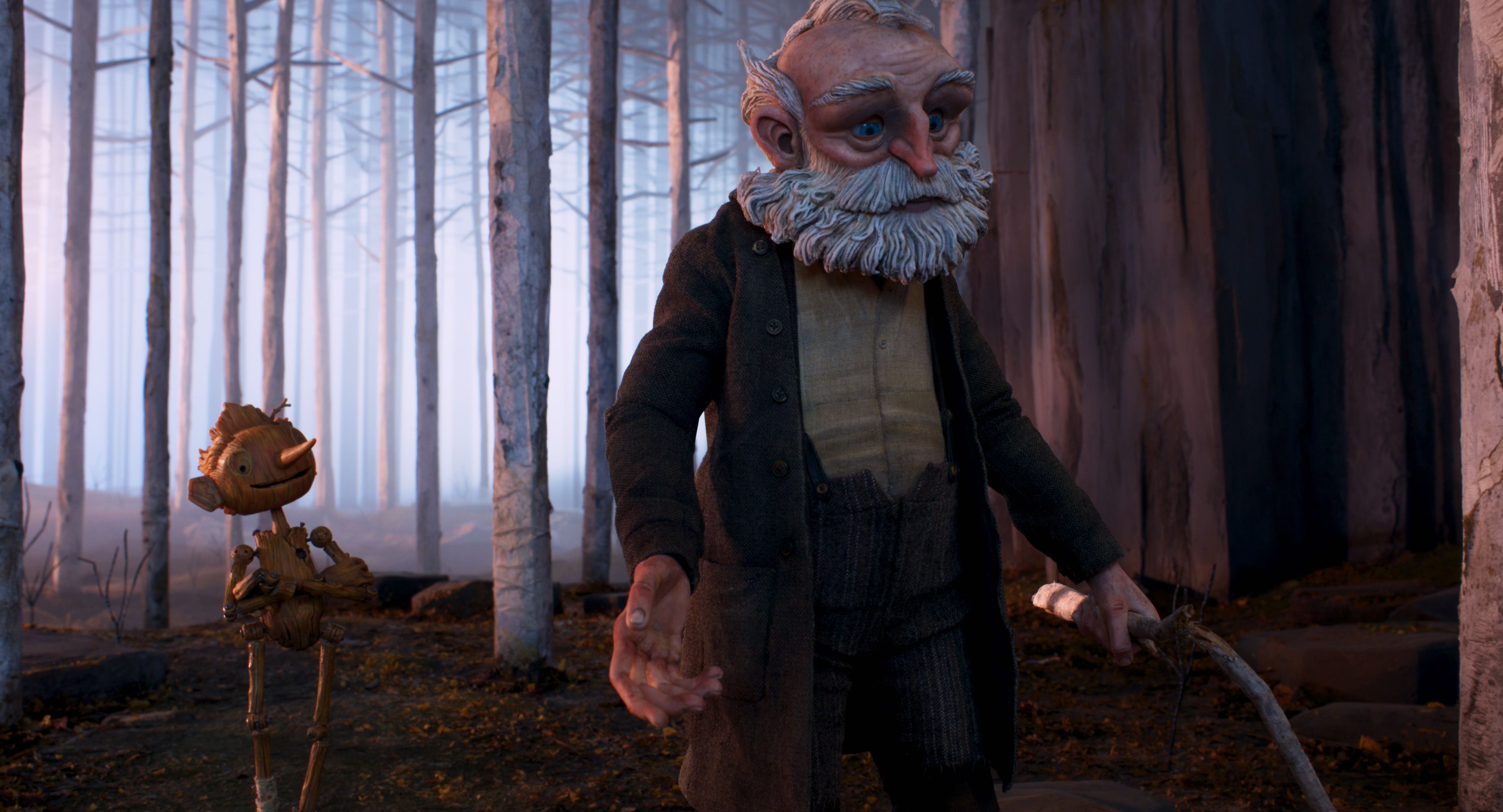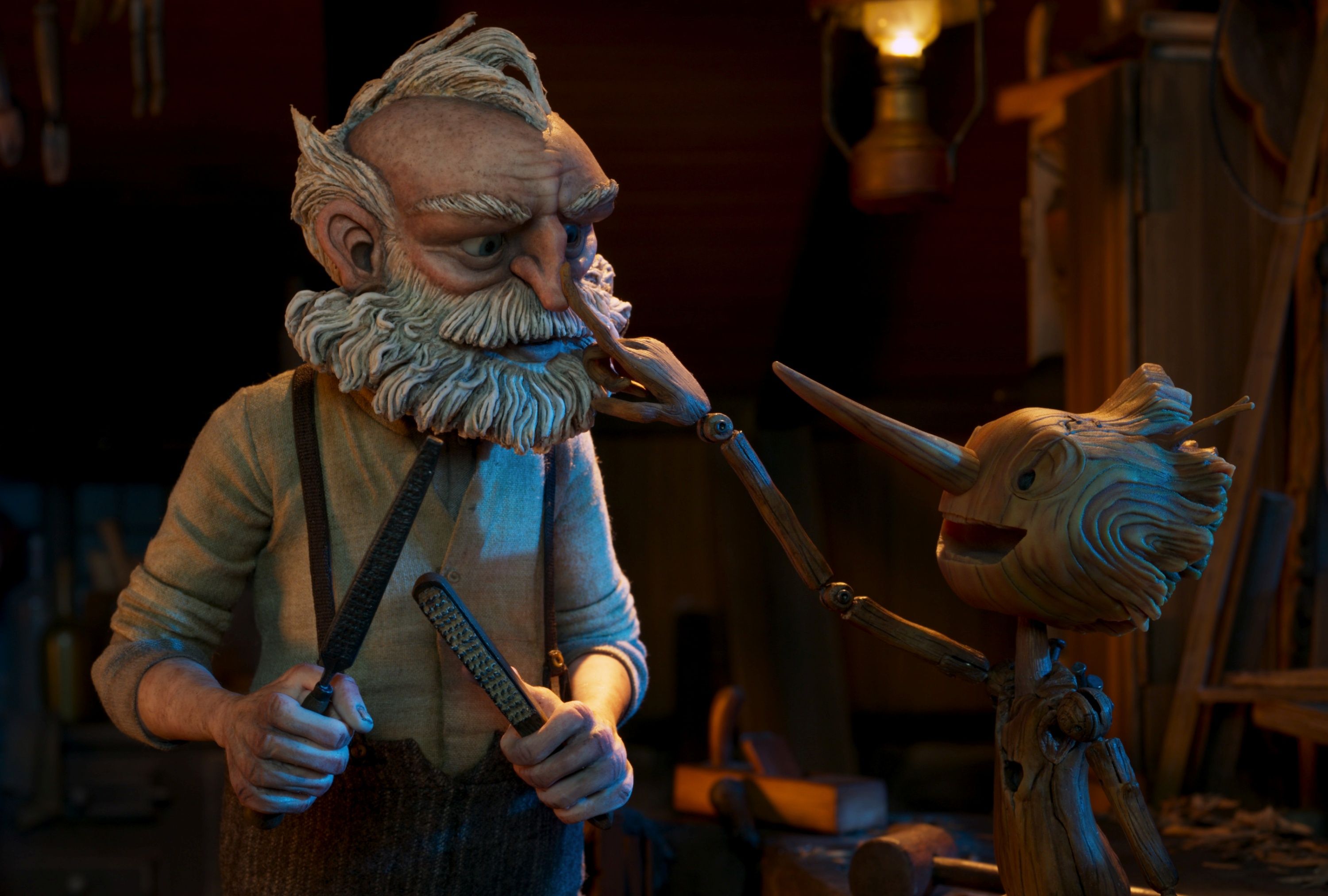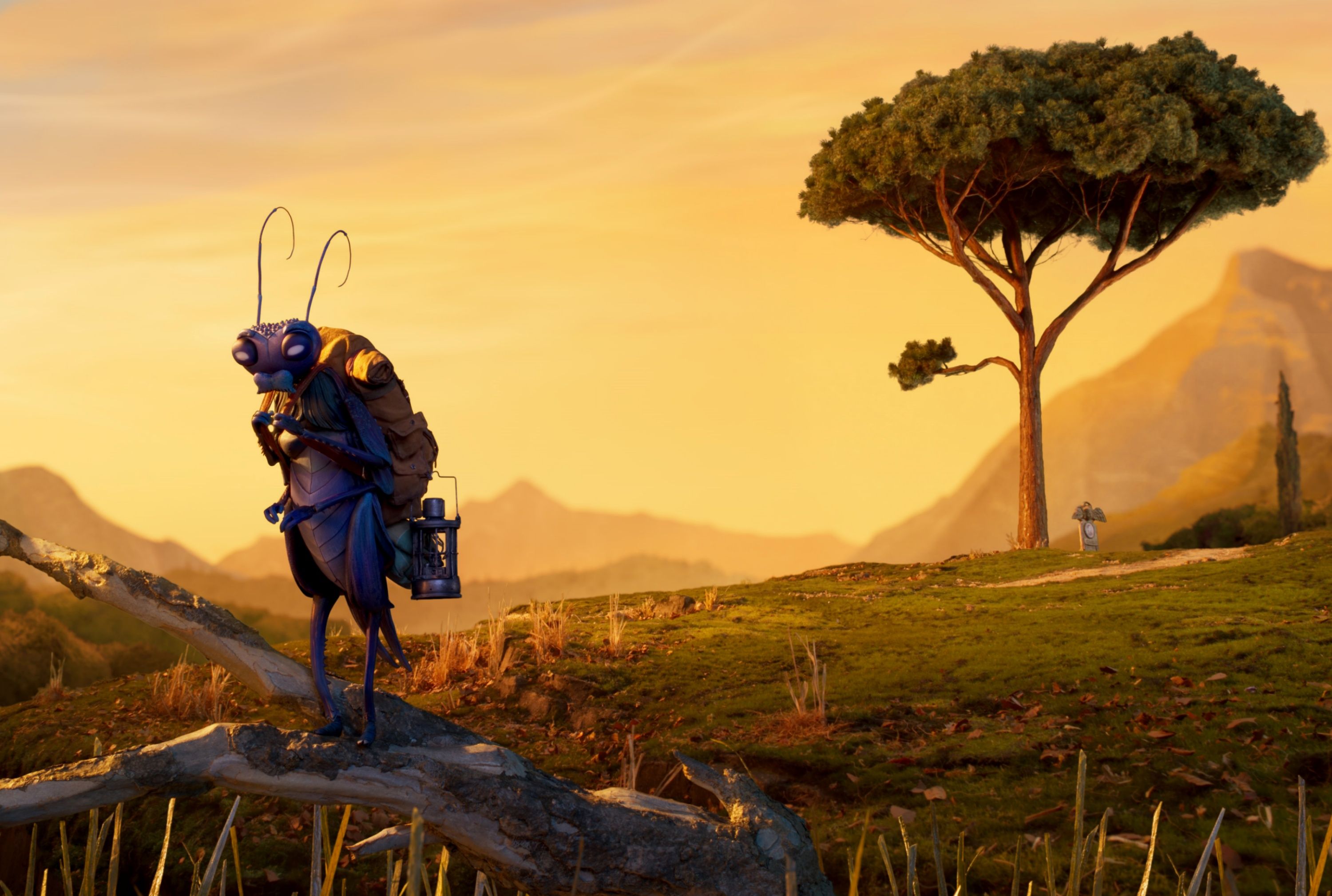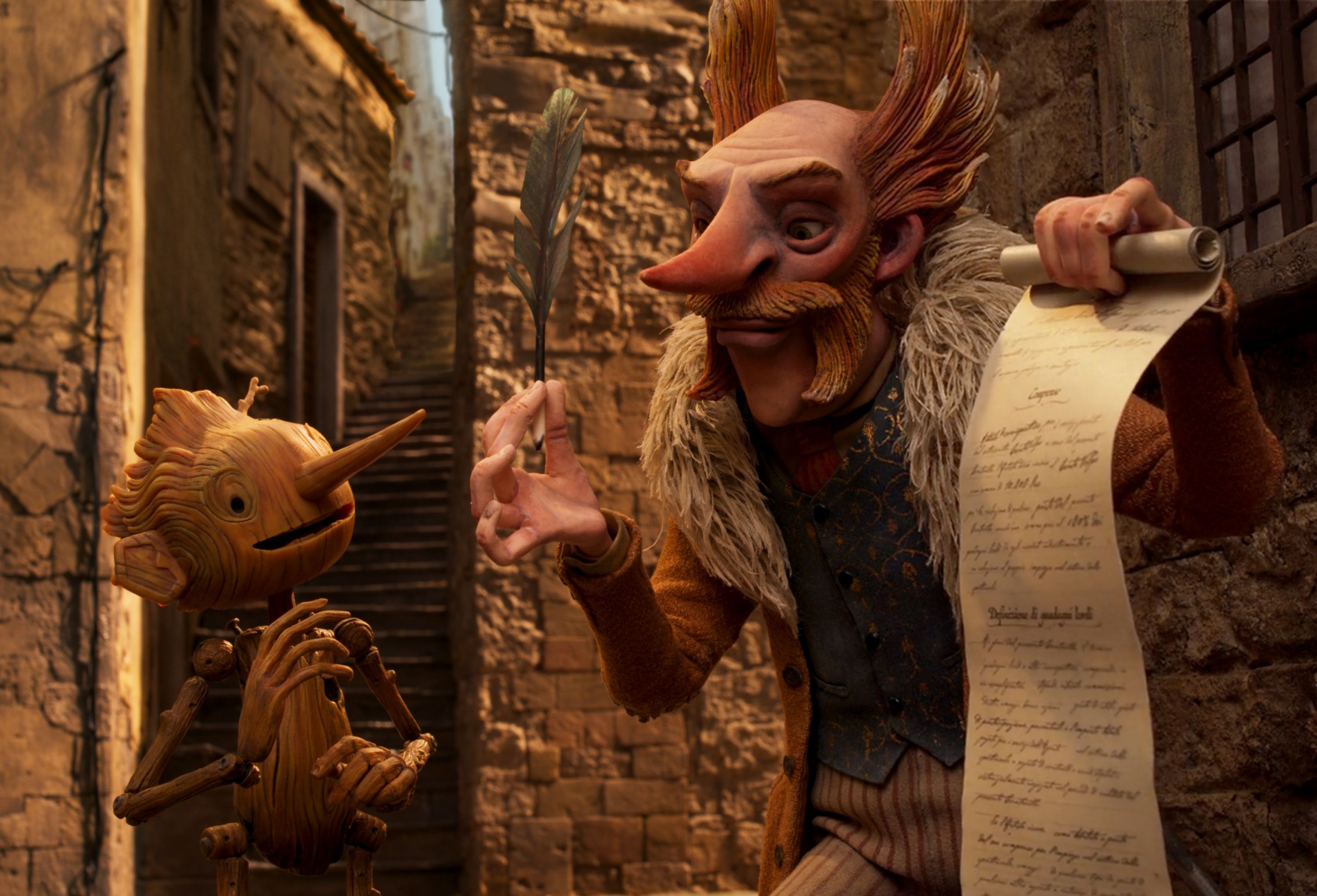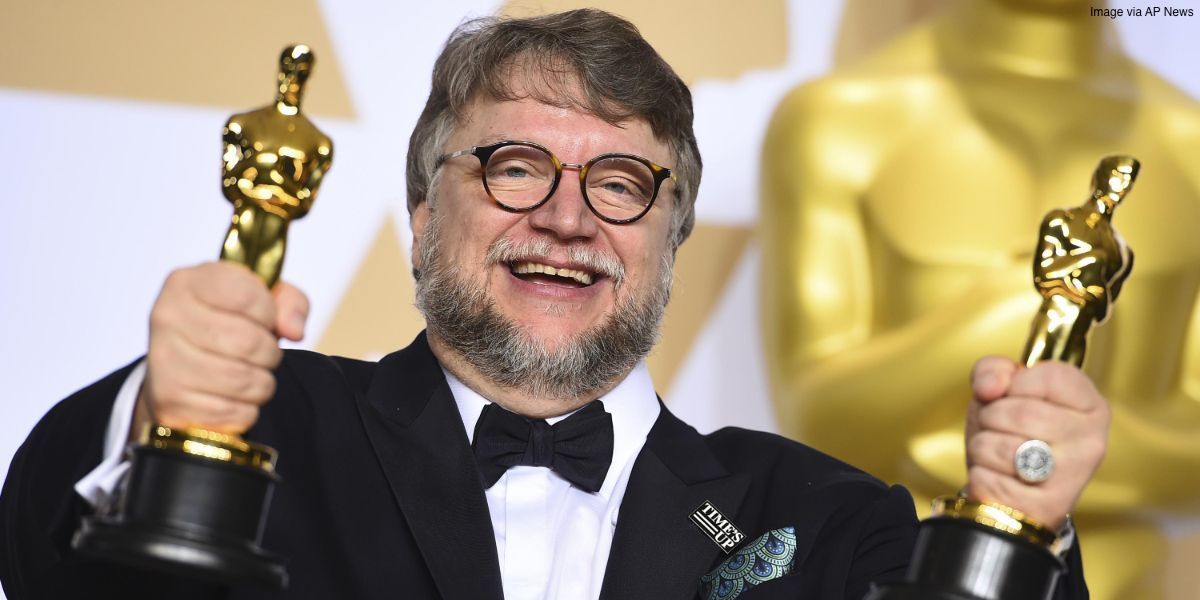It’s hard to fully understand or know the reasons why we form an emotional connection to something. From a very early age, I was drawn to stuffed animals and the personalities that I was convinced were inside each of them. That evolved into a love of Sesame Street, The Muppet Show, and Fraggle Rock, always wanting to see The Country Bears show at Disneyland, and watching Rudolph the Red-Nosed Reindeer, Emmet Otter’s Jug-Band Christmas, and later The Nightmare Before Christmas, every holiday season. That’s why I’m not at all surprised that I also fell in love with the work of filmmaker Guillermo del Toro and that I find myself so drawn to the creatures in his stories.
Collider was recently given the opportunity to participate, along with a variety of other media outlets, in a behind-the-scenes look at Guillermo del Toro’s Pinocchio, which is a stop-motion animation reinvention of Carlo Collodi’s classic tale of the little wooden marionette, magically brought to life. The film will still follow the well-known tale of the grieving woodcarver named Geppetto (voiced by David Bradley), who forms a bond with the mischievous boy made of wood called Pinocchio (voiced by Gregory Mann), only now it’s being told with the heart and through the world view of Del Toro.
The presentation gave a thorough idea of the amount of work and the amount of people needed to do all of that work, in order to complete a stop-motion project. Del Toro and co-director Mark Gustafson spoke at length about why they wanted to tell this story, what makes this version of Pinocchio different from so many others, the influence of the artwork of Gris Grimly, putting this voice cast together, following a bible of animation principles, sharing this experience with the larger creative team, how much the story and characters changed, the importance of the father-son relationship, the endless Easter eggs, and what they hope audiences take from this retelling of the famous story.
Question: What made you want to share this behind-the-scenes look at Pinocchio?
GUILLERMO DEL TORO: With this movie, we really want to reveal as much as we can about how it was made because we live in a moment where you look at something like that, and immediately you go, “Computers.” It’s incredible old world craftsmanship and artistry, where you have to take sizes and logistics into consideration. There were real sets with trap doors for the animators to come in. It’s really great. The movie you know, the more you enjoy the world.
MARK GUSTAFSON: One of our guiding principles was, if we could make it and actually physically produce it, we did that.
Guillermo, why Pinocchio? Why did this story stick with you, over the years?
DEL TORO: The two essential fables that defined my childhood and teenage years were Pinocchio and Frankenstein. That might tell you something about the relationship with my dad. It was the idea that you’re thrown into a world that you barely understand, and you try to make sense of it, as you go. They’re definitely stories that deal with that father and son link, bond and shadows. They were both of primal importance to me. Pinocchio is one of those handful of characters. There are maybe 10 characters in the history of storytelling that are capable of being universal and completely adaptable to anything. There’s Frankenstein, Pinocchio, Tarzan and Sherlock Holmes. Those are characters where, even if you haven’t read the story, you know the story, or you think you know the story. Therefore, you can use them as metaphors for science, for human emotions, and for many, many things. I’m 58, and when we started this process with Pinocchio, it was about 15 years ago or more. I thought it could be a great tool to talk about how precious and fragile we are as humans, and how much we need each other. I wanted to find a way to tell that story, in a way where you think you know it, but you don’t. We endeavored to create something where you will recognize some of the beats, but many of them are reversed, pointedly and poignantly. If we did our job right, it should work like that.
How is this version of Pinocchio different from others that we’ve seen?
DEL TORO: I would say that most every other Pinocchio story is about obedience, and ours is about disobedience. Disobedience is the primary factor in becoming human, and how becoming human doesn’t mean changing yourself or others, but understanding. The first step towards the conscious and the soul, for me, is disobedience. It’s the difference between ideas and ideology. An idea, you construct from experience and compassion and understanding. Ideology is something that is given to you, and you are told to obey it blindly. It’s also different in the fact that it’s set against a very different backdrop that illuminates a different type of paternal structure. It’s during the time of war, during the rise of Mussolini, and it’s a very lethal form of controlling paternity. It has a depth and a resonance and a poignancy that will be very much its own.
Who is Gris Grimly, and what did his images have to do with your creations here?
DEL TORO: I met Gris many years ago. I heard he was preparing a Pinocchio book, and I’m very skeptical of new interpretations. The key to Pinocchio is, who is Pinocchio? What does he look like? And the moment I saw Gris’ drawing of Pinocchio, I thought, “This is the key to making a new version.” Gris is an artist that has been active or a few decades, and he has a style all of his own. His Pinocchio was an unruly, undomesticated, innocent force of nature who's curious. Form is function and story, and the form was perfect to start.
You guys have an amazing cast for this film. How did you assemble them?
DEL TORO: When we were writing, some of the stuff was written specifically, like with David Bradley (as Geppetto). The quest for Pinocchio was really quite major. Ron Perlman had to be there, whether we wanted it or not. He had to be in the movie. Tilda Swinton was someone we wanted, from the beginning. She has this otherworldly quality that we thought would really be a tremendous help. Ewan McGregor, who is the cricket character, is the narrator of the film. We thought he has one of the warmest voices and personalities. He came in the first day and we didn’t even talk about the character. He was just into the recording session, immediately. Cate Blanchett plays the monkey and has no lines. We were doing Nightmare Alley and she said, “I wanna be part of Pinocchio.” I said, “The only part left is a monkey.” And she went, “Well, I’ll play the monkey.” She’s fantastic in it. Christoph Waltz, we thought the incredible charming, charismatic, intelligent and cruel elements that make Volpe such a great villain and manipulator. [John] Turturro has a very small but significant part. Little by little, we assembled, fortunately, the ideal cast. In the search for Pinocchio, we saw hundreds of kids.
GUSTAFSON: Gregory [Mann] was a revelation. He wasn’t terribly experienced. I think he was 10 years old, but he had such a genuine quality. It was just amazing. He stood out above everyone else that we looked at. We went, “This is our Pinocchio.” He was completely natural.
Did you really have a bible of animation principles that you were working with on this film?
DEL TORO: There were certain principles because we wanted the movie not to be like any other animation movie, really. You may have noticed that the acting is not pantomime. The acting is naturalistic, with a lot of micro-gestures from the actors. We jokingly said, “Let’s take this puppets not to silent film animation level, but actor studio level. They have throwaway gestures, they itch, they are weakened, they are tired, they have failed acts. They try to close a door, but it takes three tries to close a door. The bible came from that.
GUSTAFSON: There are so many things that you get in live-action, which is the way we approached this film. There are accidents that happen, that give you something real, that makes you feel like, “Oh, I’m watching something actually unfolding here.” And so, we aggressively went after those things and tried to build those into our animation.
DEL TORO: Accidents don’t happen when you’re moving a puppet 24 frames a second.
GUSTAFSON: Or if it does happen, it’s because the puppet topples over.
DEL TORO: In order to produce those accidents in 24 frames per second, you have to have the puppeteer try things and move around, like the different little things that we do, in daily life, or with the way the camera moves. The staging of the puppets is the way you would stage with actors. Most people are accustomed to pantomime – these poses that are almost emojis, and they’re all smart and cool and hip. We wanted life, with the design and the execution, and we wanted real actors. If we did our job right, 10 or 15 minutes into the movie, you’re watching actors and not puppets. You’ll just say, “Wow, this character is a human.”
GUSTAFSON: Pinocchio is the most fantastical element in the film, and we wanted a backdrop that he played against. If everything is magical and crazy and whimsical, then nothing is. He’s that character. He’s otherworldly.
DEL TORO: The eight rules of animation were, let’s try to animate mistakes, animate failed acts, animate characters listening, animate micro-gestures, avoid pantomime, etc. They all coalesced in what I think is a unique piece of stop-motion acting. We attempted to be naturalistic and very emotional. The movie is tackling very adult notions, but it can be watched in a family environment. It’s beautiful and moving and has an incredibly warm heart, but it deals with notions and emotions and things that will take you back to the real world.
Mark, what was your collaboration with Guillermo del Toro like? How did the two of you divide directorial duties and responsibilities on the film?
GUSTAFSON: It’s been about what phase of the production we’re in. For me, the thing that I found the most satisfying was how simpatico the two of us were. Our sensibilities and our notions of how things should happen were very much on the same page. That made it easy to go back and forth, and to figure out what we wanted from a scene. We’re different people, so we didn’t see everything exactly the same, but that’s fantastic. That’s what you want. I wanna be challenged.
DEL TORO: At the risk of sounding like When Harry Met Sally, we blend well and are completely symbiotic. I love Mark. I admire Mark. I’m happy to report that we like each other and we work more seamlessly now than in the beginning. We get along better at the end of the process than ever. We bring different values, but we have the exact same calibration for story. It’s very strange. I have an overall vision of this, and he has an overall vision of that, but we basically have the same notes, just from different points of view. Not only has it been the most satisfying collaboration for me, but it’s one of the most memorable, in 30 years of working.
What was it like to share this experience with this creative team?
DEL TORO: This is as close as I’ve ever had, in three decades, of having a circus family. We all came into the experience, and then came out of it knowing each other and loving each other. This is not lip service. It’s almost like separation anxiety. We are so close. We know each other’s advantages and disadvantages, and we talk about it very openly and beautifully. Each of the folks you’re gonna meet is an artist. What you’re gonna see in the movie is warmth and heartbreaking beauty in the film, which could not have been done, if all of us had not given this 10 out of 10, the whole time. The challenge on this movie and admirable thing about these people is that we had to deliver one hundred percent, one hundred percent of the time. It’s very rare in animated movies that somebody asks for a retake. We asked for retakes, and they did it. It’s a painstakingly handmade and hand-carved beauty that is Pinocchio.
GUSTAFSON: We were very careful in selecting our team because we wanted a chemistry that could survive the huge span of time that it would take to shoot this. We shot for the better part of a thousand days, and yet, we’re all still very close. We could have shot for another thousand days and still come out of this liking one another.
DEL TORO: Very much.
Guillermo, why did you decide to use stop-motion to tell this story?
DEL TORO: My first shorts were stop-motion. Before I did Cronos, I wanted to start my storytelling career with a full feature in claymation with puppets. My partner and I built over a hundred puppet sets. We had a couple of Mitchell cameras, and everything. And then, unfortunately for us, one night, we went to dinner and we wanted a movie, and somebody burglarized our studio and destroyed all the puppets, and they did some defacing of the walls and the sets. I said, “Well, I guess I’m gonna start with live-action.” It’s been a journey of a lifetime for me. Approximately 15 years ago, we started with Pinocchio, and about 10 years ago, I made a decision to concentrate more on animation because, and I wanna say it, right at the top, animation is film and animation is art. It is not a genre, nor is it for kids. It can address serious, deep, moving stories without having to address it as that thing. I started a long journey, co-producing and co-directing at DreamWorks. I did several features there, as producer or consultant. I co-directed and produced Troll Hunters, and we did the whole Arcadia Universe. It’s been 10 years of intensive training to get to this. We started workshopping in Guadalajara in stop-motion. I started a scholarship dedicated to young animators going to Paris. So, this is not just a whim or an exception. It’s been a journey to get here.
Curiously, this is the year for stop-motion. We have beautiful stop-motion movies in the arena of animation right now. Stop-motion is one of the arts that is in perpetual extinction because it’s very particular, it takes a long time, it takes a lot of effort, and everything is physical. You have to solve it. You cannot just move a puppet. You have to come through a trap door to move it, and you have to figure out the distance between the camera and the puppet. It’s something that I’ve studied since I was a child, all the way until now. There’s something beautiful about the story of a puppet that refuses to obey, where everybody else behaves like a puppet, and obeys and conforms, and the story is told with puppets. There’s something really magical about that.
One of the things we wanted was for you to be able to see that it’s stop-motion. You should be able to see the fabric moving a little and things should be a little jittery. When I was a kid, and this will age me perfectly, I used to be fascinated by the View Master reels that had maquettes of little figures in little worlds. When we started talking, I said, “I want everybody to understand that these are miniatures in the beginning, and then eventually fall into the world.” It was the only way to do it. The key to Pinocchio is Pinocchio. There’s an uncanny valley of the size of the world, if Pinocchio is not believable. The only way to do Pinocchio is animation, to make it a puppet. In my view of the story, the only solution is an animated character, and the material nature of the wood made it perfect for stop-motion.
What has making this movie taught you about animation and stop-motion in Mexico?
GUSTAFSON: It’s taught me that there’s a vibrant community down there, that I was unaware of before this production. There’s a lot of talent, and it was vital for us to use them. They did a fantastic job. We found a section of the film that we were able to set aside, that lived on its own, and they tackled that. With all of the building and everything, they took it on and they did a fabulous job.
DEL TORO: For me, it was vital. I’m 58, and I’m very aware that the only thing that you do in this world is leave something behind for some other people to continue. The rest is immaterial. The rest goes away. But if you made something a little better and that continues after you, that’s incredibly beautiful. Fortunately, the animation movement in my state was started by me and my partner with those cameras. The cameras survived the burglary and they went on to be used by several of the communities that ended up animating Pinocchio. I just thought Pinocchio was the perfect way to showcase that talent. We had about 40 people in Guadalajara, Mexico, in a big arena. They were fantastic animators. They were world-level animators. Logistically, it was complicated, but it was very fruitful. We had to interact between London, Portland, and Guadalajara. People went to London to learn the more technically challenging puppet making. But it was all worth it. Now, we have this test case study with Pinocchio. We wanted the animators in Guadalajara to animate Pinocchio and the cricket. We wanted them to animate main characters, and what they do is beautiful. And it’s not only in Mexico. In Mexico, you have many people doing great stuff in stop-motion, but you also have Chile, Argentina, and Brazil. To me, animation is really important in Latin America because you can end up doing it with very few resources, if you need to. It can be an animator and the puppets, and you can stay for a year and do a short that challenges government, or an idea. It can be a beautiful tool for expression. The more we do it, the better it is to give this tool to the people coming up.
How much did the story change, from its conception through all the years it was in the process?
DEL TORO: There’s a moment in which the story changed very deeply for me. Around 2009, I had to restart the screenplay from zero, with Patrick McHale. And then, about five years ago, I lost my father and that informed a lot of the depth of emotion of this movie for me, and the thematic importance of how brief life is, how important it is, and how we have each other for so precious a moment. The material dictates itself. The collaboration was incredibly beautiful with everyone. Everyone was minding things. I could agree or disagree, but the feedback was beautiful, and it changed everything. I’ll give you an example – a week or two too late to do it, we changed villains. The original villain was Mangiafuoco, which is a different character that is big and burley. We were watching Volpe and I said to Mark, “Isn’t Volpe a much better villain, and a better design.” Originally, Ron Perlman was gonna play Mangiafuoco, and I said, “Imagine Christoph Waltz playing this character.” So, we rewrote the screenplay. Mark and I went to Alex [Bulkley], our producer, and we said, “We’re gonna switch.” This switch, just so you understand, means that a puppet that was made for a few scenes, we’d now have to create 30 puppets for, for many scenes. It was a huge change, but creatively, it made sense. One of the things we celebrated in this is that we could let the material shape the story, as we went along.
The father-son relationship is such a central theme in Pinocchio. What were some references you used for inspiration for the relationship you wanted to display between Geppetto and Pinocchio?
DEL TORO: Well, I’m a father and I’m a son, and I have huge experience in both arenas. I wanted to present three fatherly figures. A big difference with our Pinocchio is that he normally learns to obey and to be a good boy, and then he turns into flesh and blood. What I wanted, very much, is for everybody to learn from Pinocchio. The cricket is stodgy and stringent. He learns humility and fragility and fallibility from Pinocchio. Geppetto starts the movie saying, “It has to be perfect!” He wants everything to be just so. Everybody loves Geppetto because Geppetto does what everybody wants. When his child reincarnates in Pinocchio, he cannot see it.
What I’ve learned, as a father and as a son, is that the greatest treasure, for a son or a father, is to be seen. To be able to be seen by the other is so eloquent and moving. I want to tell that little story, in which Geppetto learns to love him, through the course of the movie, for who he is. Pinocchio is such a pure element that he changes the alchemy of everybody around him, for good or worse. He irritates the figures of authority, and he wins the heart of his father, when he recognizes his essence. Those are things that were important for me. I think the movie is a beautiful movie. It’s not a movie catering to what people expect from a movie for kids. It’s a very beautiful, heartfelt movie, but it’s also a beautiful movie to discuss with your kids. You’re a father, but to you, you’re Guillermo. Those are the things that I used – our lives, whether it was Mark, Patrick, or myself.
Was there an animated movie or TV series that made you fall in love with animation?
GUSTAFSON: For me, it was Ray Harryhausen and the Sinbad movies. That was my first exposure to stop-motion, and there was a magic to it. In all of its somewhat crudeness, I was completely drawn in. I was aware that it was not real and that they were puppets, but what he did with them was just remarkable. That really left a mark on me. And then, when I grew up and was able to actually get into this business and start doing stop-motion, I understood the attraction to that. I never had to give up playing with my toys. The way we interact with these puppets now is the same way that I interacted with my dolls – my G.I. Joe and stuff – when I was growing up. As a child, I probably made hundreds of movies, but I never shot any of them. They were all happening in my head.
DEL TORO: The origin is sort of the same for me. It was a combo between Ray Harryhausen and the original King Kong, from Willis O’Brien. I knew they were little, and that made it even more magical because of the toy factor. If you consider the etymology of animation, to animate is not to move a puppet, it’s to infuse it with a soul and to make it live. Harryhausen and King Kong did that or me. We would always say, if we didn’t like something in the shot, we would go back and ask, “What is the puppet thinking? What is the thought?” I wanna know what the puppet is thinking, and you find that in the eyes.
GUSTAFSON: If I’m talking to an animator about a shot, the first thing I talk about is the eyes, and then it cascades out from there. When you see a character thinking, they’re alive. They’re processing information. They’re not talking, they’re thinking.
DEL TORO: The micro-gestures of Geppetto or Pinocchio or Volpe are so extraordinary to see, whether it’s the trembling of a lip or the change of direction of an eye before giving an answer. Body language was very important.
Details have always been a key factor of your storytelling. Did you approach inserting details into your work any differently in this art form, compared to your previous works? Are there any details that you’re particularly proud of?
DEL TORO: The movie is full of them. When you see a tool is worn and it’s oily from being handled with hands, and you see Geppetto’s fingernails, they have been hammered and they’re a little coarse. And when you see the knuckles, there are a callouses and blood concentrations. Form is storytelling. It’s impossible for someone to talk about the look and they story because they are one and the same. Everything is an Easter egg. Everything is full of details. Of course, there are inside jokes, like putting the Fawn from Pan’s Labyrinth in one of the windows, or little gestures to Devil’s Backbone. For me, this movie is a companion piece. It’s the third movie in a trilogy with Devil’s Backbone and Pan’s Labyrinth. That’s where the movie belongs. Those are the three movies about childhood and war. The whole movie is, in that sense, of a piece with those.
Will we get to experience any new creations that are not in the original novel or previous films?
DEL TORO: Yes, completely. I think the experience will be very different. If we did our job right, one of the biggest juggling act we had is that the movie should flow. The themes of war and the period and fatherhood should all meld, and you should recognize the story of Pinocchio, but you should see the difference of what takes the place of Pleasure Island, for example. Each of the beats will be there, but the way we execute them is very different and sometimes contrarian. If you’re looking for Easter eggs, you’ll see the window from The Shape of Water in Geppetto’s workshop. You have Disney’s Pinocchio. You have Carlo Collodi’s Pinocchio. This will be of a piece with what you think I do, and I’m very happy with that. It’s like when you sing and your voice changes the song.
GUSTAFSON: What I found attractive about this story was the way that Guillermo and Patrick turned it on its ear. They flipped the central conceit of the story, which opens up the story in a completely different way, so you get to make different choices and it’s also the reason why this is worth telling again. We have a completely new take on it, and yet it still lives within the world of Pinocchio.
DEL TORO: For example, one of the things we did is that the character that changes the most, more than any other version of Pinocchio, is Geppetto. We track Geppetto much more. It is his grief, his loss, his understanding, his change. He’s not just a vehicle to function as a father figure for Pinocchio. The weight Geppetto has is very different. That’s why we needed the puppets to be actors. Geppetto is one of my favorite actors in the film.
You’ve said that in life, the important thing is to leave something behind. What do you want to leave behind with your Pinocchio?
DEL TORO: For us, in a practical sense, we are part of a history of stop-motion. As far as the stories, I think that all the movies you make are one movie. The ideas that are expressed, eloquently and emotionally, again and again, tell the world part of a song that is never completed by one artist. The final lines in this movie are a summation of what I understand life is. It is so urgent, right now, for me to realize that totalitarian thought is so suffocating. We have each other for so brief a time. You can choose between fear and love, in the way you relate to people. Everything turns around, if you look at it with love. I think that’s one of the urgent messages of the film.
Guillermo del Toro’s Pinocchio is in theaters in November and available to stream on Netflix in December.

